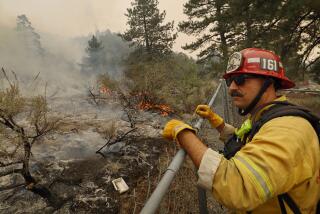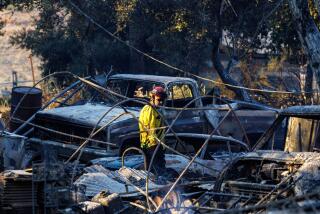Amid California’s drought, many wildfires but no disasters — yet
Reporting from OAKHURST, Calif. — With California zeroing in on a thousand days of drought, people here shifted their gaze this week with a sense of dreadful certainty, from the cracked soil and parched tinderbox at their feet toward a plume of smoke rising from the woods somewhere off Quail Drive.
It was one year ago, after all, that the Rim fire raged unchecked through the Sierra Nevada, burning so ferociously that it generated its own wind while consuming 400 square miles of wilderness.
This, surely, would be the same: The state has only grown more desiccated, and that little plume off Quail Drive erupted into an uncontained blaze that cast embers a half-mile into the sky. The authorities issued evacuation orders for 13,000 homes and businesses and prepared to retreat as the flames marched toward a propane storage yard.
And then, it didn’t happen.
The Junction fire was still burning Wednesday, and had destroyed nine structures. But the wind had calmed, and firefighters, aided by high humidity, attacked the blaze deftly and aggressively and were holding it steady at about 600 acres. Roads were reopened and evacuation orders rescinded, and it did not appear that this fire would grow into the sort of regional conflagration authorities have been bracing for — again.
This year has marked a paradox in California and the West: Under terrible drought conditions, there has been a startling number of wildfires. But none has detonated into catastrophe.
Dale Miller, 77, a retired fire battalion chief, was in Fresno undergoing chemotherapy when he heard that the Junction fire had caught near his home in Oakhurst, one of the more prominent “gateway” communities leading to the southern entrance of Yosemite National Park. A friend reported that the blaze hopped over one nearby hill with the ease of a child hopping over a jump rope.
“I thought it was another Rim,” Miller said.
But when Miller got home, the worst had not materialized; by Wednesday, the fire was already 40% contained.
“I’m amazed they corralled this thing,” Miller said. “Look at all this dry brush.... Anyone with eyes can see how dry it is. We were really lucky this time.”
It was a pattern that has played out time and again this year. The question is: How long can California and the West continue playing with fire?
California is well into its third year of a debilitating drought. According to the U.S. Drought Monitor report, 99.8% of California’s 164,000 square miles is in a state of “severe” drought and more than half the state is suffering from “exceptional” drought — the harshest of the government’s five-tiered scale.
In those conditions, wildfires are erupting with abandon.
Firefighters with the state’s Department of Forestry and Fire Protection, which provides fire service to communities and land across California, have fought more than 4,000 fires so far in 2014. That’s an increase of more than 500 fires from the same period last year.
All told, local, state, federal, military and Native American tribal fire agencies have battled 5,897 fires — which means that a new forest fire has started every 56 minutes.
And yet, none of those fires has erupted into a “really big, Rim-fire type disaster,” said Bill Stewart, a forestry specialist with the College of Natural Resources at UC Berkeley.
“Some of them usually escape,” Stewart said. “This year — to date — it hasn’t happened.”
That’s not just true in California, but across the West, Stewart noted. Despite dry conditions across the region and a high incidence rate of fires, the West has lost 2.5 million acres to flames this year, the second-lowest total in the last 13 years, he said.
Some of that is not coincidence. Government officials have launched an aggressive campaign to guard against large wildfires.
In June, state fire officials banned most forms of controlled burns across 31 million acres, including techniques used to manage forests and clear hazards. And state inspectors began enforcing “defensible space” ordinances in many communities, requiring homeowners to surround houses with a 100-foot-wide perimeter clear of flammable materials.
But much of the pattern comes down to chance, Stewart said.
“No one really has an explanation. We’ve just been really lucky,” he said. “It’s surprising everybody.”
The run of luck will be increasingly difficult to sustain, however, as seasonal winds begin to roll in. A combination of fire in dry areas and powerful winds is often what leads to real catastrophe.
“That’s what changes the fire behavior from something they can put out to something they can’t,” Stewart said.
The arrival of the wind could undo another surprising wrinkle in California’s fire activity this year: Many of this year’s more significant blazes have taken place in Northern and Central California, including the 4,000-acre Butts Canyon fire in Napa County and the El Portal fire, which burned 4,700 acres at the western edge of Yosemite, just south of the area burned in the Rim fire.
Of the more than 20 wildfires now burning in the state, only three are in Southern California — a total of little more than 400 acres. In contrast, a single wildfire in Northern California’s Lassen National Forest has burned almost 40,000 acres.
In the Sierra Nevada foothill communities where the Junction fire burned this week and residents endured yet another frightening bout, many know the worst could still be ahead. Wildfires used to be part of the routine in this stretch of the state — part of the natural cycle, part of the workaday life. No longer — not amid these drought conditions.
“Now, every fire, every time the wind blows, I pray,” said Janelle Moisa, 57, who lives in the area.
Moisa and her three grandchildren were eating french fries at Robert’s Frosty in Coarsegold, a popular spot along California 41, the highway that leads to a primary Yosemite entrance, which was closed at the onset of the fire. As they ate, a firetruck honked and passed.
“That’s Uncle Gilbert!” shouted 13-year old Kalub Moisa. Kalub has one uncle and three cousins who are firefighters, which is not uncommon in the area.
“A fire could burn down my whole town,” Kalub said. “We were just lucky this time.”
[email protected]
Twitter: @dianamarcum
[email protected]
Twitter: @mtthnsn
[email protected]
Twitter: @scottgoldLAT
Marcum reported from Oakhurst, Hansen and Gold from Los Angeles. Times staff writer Veronica Rocha, in Los Angeles, contributed to this report.
More to Read
Sign up for Essential California
The most important California stories and recommendations in your inbox every morning.
You may occasionally receive promotional content from the Los Angeles Times.












